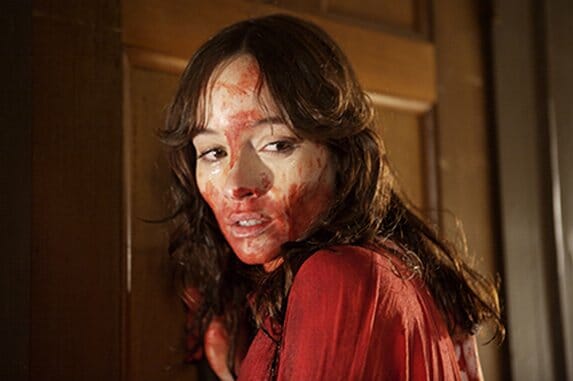Introducing Endless Mode: A New Games & Anime Site from Paste
Release Date: October 30
Director/Writer: Ti West
Cinematographer: Eliot Rockett
Starring: Jocelin Donahue, Tom Noonan, Greta Gerwig
Modeled after the lo-fi slasher films that sprouted in the early ’80s, the plot follows the 24-hour descent of Samantha (Jocelin Donahue), an intelligent, grounded college sophomore desperately searching for a means to pay rent on a new apartment. After tripping on an ominous babysitting flyer, Samantha finds herself marooned in a secluded Victorian mansion where a morose elderly couple informs her that they don’t actually have children, but will pay her $400 to watch over the house and a grandmother hidden in the attic. It doesn’t take long for Samantha to discover that she has literally taken the job from hell.
It would be easy to cite the pitch-perfect acting for the narrative’s sheer gravity. Donahue shines, breaking the mold of the clueless teen fodder archetype; she sees the warning signs of her bloodstained trajectory, but doubts her intuition for a needed payday. An expert audience surrogate, Donahue will make you feel every bead of sweat and adrenaline spike (and there are many) as she ebbs closer to an unavoidable fate. And then there’s Tom Noonan. A B-Movie veteran who can lower room temperatures with his pacified monotone, Noonan evokes innate disgust and wonder as a religious fanatic (we’re not saying which religion) whose calm demeanor coexists perversely with a much, much darker side.
Although the acting is top notch, it shares the honors in a trifecta of inspired direction and cinematography. The Roost director Ti West may have modeled his work on grainy, gore-a-minute blood baths, but this is anything but. Instead, he creates such a grounded, practical reality, that when the pressure finally implodes in the white-hot 20-minute climax, it pierces like a pitchfork. Ti and cinematographer Eliot Rockett can also take the cake for the biggest camera teases of the year. Employing a stinginess Hitchcock would applaud, they keep the juicy bits a tantalizing inch off screen, letting the audience’s imaginations and pulses run wild until the finale.
The actual narrative is rooted in the Satanic Cult sensationalism that ran rampant throughout the ’80s. The testimonies from alleged victims throughout the decade adds a creepy, if not necessarily accurate, historical parallel that only makes the ride that more engrossing for those who remember. If there’s a minor gripe, a latter supernatural bent actually dilutes the immediate reality found in the rest of the feature and this specific footnote.
After watching The House of the Devil, the details will creep into the crevices of your mind, making you obsess over the haunting coincidences, hints and movements. The production is an achievement for the genre in its discipline and restraint, keeping 5/6 of the ride (relatively) bloodless and air-taught, manipulating the audience to a dreadful conclusion that builds from the film’s first five minutes and detonates without mercy. You may not be able to watch this twice, but you’ll certainly remember it forever.
Studio/Run Time: Magnolia Pictures/93 mins.
The devil’s in the details of this modern horror classic
The House of the Devil isn’t just a movie: it’s an experience.It joins the league of Rosemary’s Baby, The Exorcist and The Omen as one of the most diabolical entries in the modern horror library.And as you can probably guess, it’s also batshit scary.
